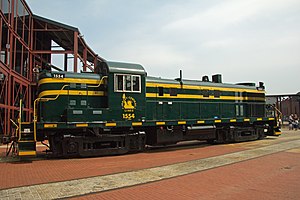ALCO RS-3

A former Central Railroad of New Jersey ALCO RS-3 at Steamtown National Historic Site
|
|||||||||||||||||||||||||||||||||||||||
|
|||||||||||||||||||||||||||||||||||||||
|
|||||||||||||||||||||||||||||||||||||||
|
|||||||||||||||||||||||||||||||||||||||
|
|||||||||||||||||||||||||||||||||||||||
| Type and origin | |
|---|---|
| Power type | Diesel-electric |
| Builder |
American Locomotive Company Montreal Locomotive Works |
| Model | RS-3 |
| Build date | May 1950 – August 1956 |
| Total produced | 1,418 |
| Specifications | |
|---|---|
| Configuration: |
|
| • AAR | B-B |
| Gauge |
4 ft 8 1⁄2 in (1,435 mm); 5 ft 3 in (1,600 mm) for Brazil |
| Trucks | AAR type B |
| Wheel diameter | 40 in (1,016 mm) |
| Minimum curve | 21° |
| Wheelbase | 39 ft 4 in (11.99 m) |
| Length | 56 ft 6 in (17.22 m) |
| Width | 10 ft 1 5⁄8 in (3.089 m) |
| Height | 14 ft 5 1⁄8 in (4.397 m) |
| Loco weight | 247,100 lb (112,100 kg) |
| Prime mover | ALCO 244-D |
| Engine type | V12 Four stroke diesel |
| Aspiration | Turbocharger |
| Generator | GE GT-581 |
| Traction motors | (4) GE 752 |
| Cylinders | 12 |
| Cylinder size | 9 in × 10 1⁄2 in (229 mm × 267 mm) |
| Performance figures | |
|---|---|
| Power output | 1,600 hp (1.2 MW) |
| Tractive effort | 61,775 lb (28,021 kg) |
| Career | |
|---|---|
| Locale | North America; Spain (purchased from US railroads); Brazil (MLW); |
The ALCO RS-3 is a 1,600 hp (1.2 MW), B-B road switcher diesel-electric locomotive. It was manufactured by American Locomotive Company (ALCO) and Montreal Locomotive Works (MLW) from May 1950 to August 1956, and 1,418 were produced — 1,265 for American railroads, 98 for Canadian railroads, 48 for Brazilian and 7 for Mexican railroads. It has a single, 12 cylinder, model 244 engine.
ALCO built the RS-3 to compete with EMD, Fairbanks-Morse, and Baldwin Locomotive Works. In 1949, EMD introduced the EMD GP7. In 1950, Fairbanks-Morse introduced the 1,600 hp (1.2 MW) H-16-44. Also in 1950, Baldwin introduced the 1,600 hp (1.2 MW) Baldwin AS-16. In the case of ALCO, Fairbanks-Morse, and Baldwin, each company increased the power of an existing locomotive line from 1,500 to 1,600 hp (1.1 to 1.2 MW), and added more improvements to create new locomotive lines. All of this was to be more competitive with EMD. ALCO's 1,500 hp (1.1 MW) line was the RS-2, although 31 were built in 1950 with 1,600 hp (1.2 MW). Fairbanks-Morse's 1,500 hp (1.1 MW) line was the H-15-44. Baldwin's 1,500 hp (1.1 MW) line was the Baldwin DRS-4-4-1500. EMD, however, kept its competing GP7 at 1,500 hp (1.1 MW). But in 1954, EMD introduced the GP9. It was rated at 1,750 hp (1.30 MW).
EMD won the road switcher production race, though. EMD produced 2,729 GP7s. ALCO produced 383 RS-2s, and 1,418 RS-3s. Fairbanks-Morse produced 30 H-15-44s, and 296 H-16-44s. Baldwin produced 32 DRS-4-4-15s, and 127 AS-16s.
...
Wikipedia
